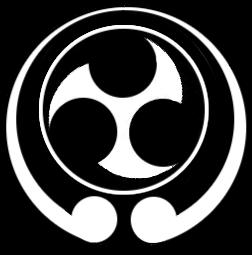
![]()
![]()
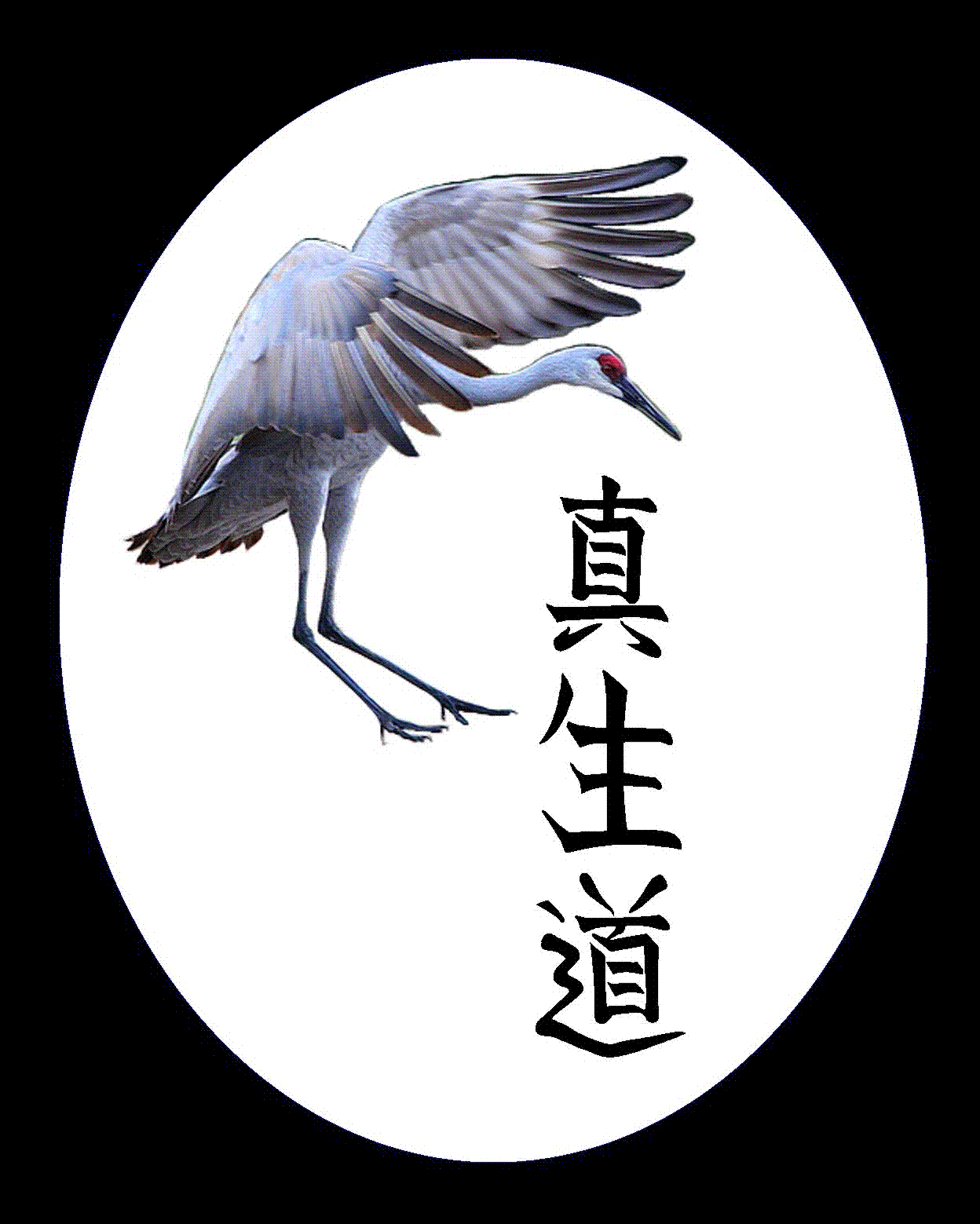
Headingley Karate
|
|
|
Fire Melts Metal? Can we apply Chinese Medicine to Pressure Point Fighting?
Zoltan Dienes & Mike Flanagan - May 2001
Introduction
In recent years the subject of 'pressure point fighting' or kyusho-jutsu has caused a good degree of excitement, and also some controversy, in the world of martial arts. There are practitioners who endeavour to use pressure points in every technique they do, and there are others who think that pressure points would not work in a real situation, and avoid them altogether. The authors are both firm believers in the use of pressure points to increase the effectiveness of already good technique.
Having accepted the usefulness of pressure points one is then bound to ask "What are they?", "How do they work?" and "How best can I use them?". A popular way of explaining how pressure points work is to describe them in terms of Chinese medicine. Traditional Chinese Medicine (TCM) is a system of thought that is at least 2,500 years old. Some aspects of medicine have been associated with martial arts in the orient for hundreds of years. The reasons for this are obvious – it is clearly useful for martial arts teachers to have some experience of addressing the kind of training injuries that martial arts students are likely to encounter. Such knowledge is likely to have been passed down through the centuries along with the martial arts being taught. It seems only natural then that the principles and theories of Chinese medicine might be used to explain the effectiveness of certain aspects of martial arts. This is nowhere more evident than in the field of pressure-point fighting – in which nowadays the names for the 'pressure-points' are often taken directly from the tsubo's, or vital points, of Chinese medicine. In this manner, a number of theories have been taken directly from Chinese medicine and applied to martial arts. But is this an appropriate application of those theories? The main focus of Chinese medicine is to address imbalance in human beings, striving towards the creation of harmony and therefore the absence of disease. For the TCM practitioner this often involves an extensive examination of the person, and a holistic and extended course of therapy. But it is far from obvious how these theories should be applied to the problem of harming rather than healing, using martial art techniques rather than needles or massage, finishing a fight in seconds rather than a course of therapy over months. Many people have attempted to apply the concepts of TCM to martial arts without demonstrating that the principles themselves were adding anything useful to the effective techniques they employed. We considered that this was a subject worthy of more rigorous investigation and so, beginning in 1998, set about designing a number of experiments to test the validity of some of the ways in which concepts of Chinese medicine had been applied to the martial arts.
The first two experiments were designed by Zoltan Dienes; the latter two by Zoltan Dienes and Mike Flanagan.
Flowing colours
In traditional Chinese thought there are five phases or elements that exist in nature, and each element has an associated colour. These are blue (or black) for water, green for wood, red for fire, yellow for earth and white for metal. Some martial artists believe that envisaging a particular colour, or even imagining 'flowing' that colour into an opponent, will enhance the effect of attacking particular pressure points. The colour is chosen in accordance with the Five Elements so as to provide maximum disruption to the energy of that point. Points lie along channels called meridians; ten of the twelve meridians are associated with a particular element. Thus, most points are associated with one of the elements, and hence with a certain colour. In 1998 Zoltan attended a seminar in which the instructor demonstrated this principle using the wrist lock known as nikkyo, or s-lock. Anyone who has been on the receiving end of nikkyo can attest to how painful the experience is! The seminar instructor demonstrated the lock and showed how envisaging 'flowing yellow' into the opponent enhanced the lock and made it more effective; he said that flowing the colour would mean people could use half the amount of force to get the same reaction. Indeed, many people attending the seminar were surprised at how well this worked. Zoltan reproduced this session with 2 groups of karate students. First he taught the whole group how to apply nikkyo. Then he taught Group A that flowing red would increase the effectiveness of the lock and that flowing blue would decrease its effectiveness. Group B were taught the exact opposite: blue would increase the effectiveness of the lock and red would decrease it. When questioned at the end of the session each group found that what they had been told appeared to be true. Those who were told that flowing red would enhance the lock found that to be the case, the other group found that flowing blue was more effective - in fact, they found the colour they THOUGHT should work better to be about twice as effective as the other colour, just as had been suggested to them by Zoltan. The only conclusion that can be drawn from this is that it is not the colour that is important but the students' belief in its effectiveness: positive thinking and commitment to your technique will make it a more effective technique.
Vibration
Each of the Five Elements also has an associated musical note. Nikkyo (s-lock) has again been used to demonstrate that vibration at certain frequencies can enhance a technique's effectiveness. This is achieved by vibrating the arm very slightly, at a particular speed, whilst applying the lock. It should be noted that these movements are much smaller than the random movement some practitioners employ to confuse an individual who is succeeding in resisting the application of a lock. As in the previous experiment 2 groups of karate students were taught to apply the lock with and without vibration. Group A were taught that vibration would enhance the lock. Group B were taught that the lock was best performed as smoothly as possible and that vibration would detract from its effectiveness. Both groups found their experience matched their expectations. Group A did indeed find that vibration was helpful in applying this lock, group B found that vibration detracted from its effectiveness, roughly by the factor of two that was suggested to them. Again it must be concluded that each student's belief with regard to vibration was far more important than the actual vibration itself.
Fire melts Metal
The central theme of the Five Elements consists of the relationships between the elements themselves. These relationships are expressed as 2 cycles. The creative cycle states that water creates wood, wood creates fire, fire creates earth, earth creates metal and metal creates water, thus completing the cycle. The control cycle states that water controls fire, fire controls metal, metal controls wood, wood controls earth and earth controls water, again completing the cycle. Amongst those who use Five Elements in order to select relevant pressure points to attack, the most widely used and commonly agreed principle is the use of the control cycle, sometimes referred to as the destructive cycle by martial artists. The basic idea is that if one attacks a vital point on, say, a fire meridian then this will affect the flow of qi, or energy, in the metal meridians, as fire controls metal. Therefore an attack to a point on a metal meridian will have a much greater effect on the energy in that meridian IF it has been preceded by an attack to a fire meridian. To put this in plain English: grabbing Heart 6 (fire) on the wrist and striking Large Intestine 18 (metal) on the neck is more likely to knock the person out than simply striking Large Intestine 18 on its own. As another example, consider the photos below. In response to being grabbed, uke (the defender) first strikes Large Intestine 10, a metal point. This cause tori (the attacker) to bend in such a way that Gall Bladder 20 (a wood point) is exposed. Metal controls wood in the destructive cycle, and by striking Gall Bladder 20, uke can easily knock tori out.
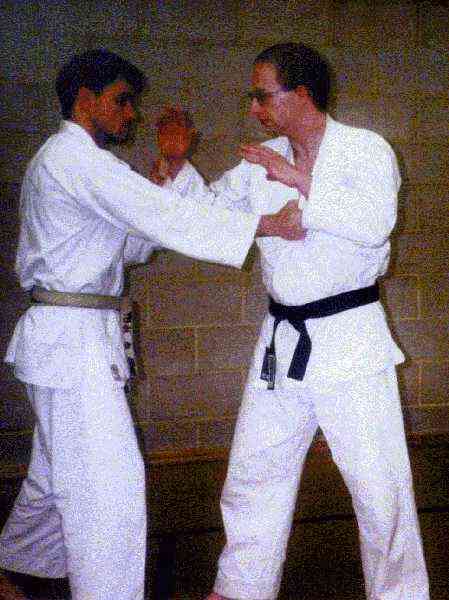
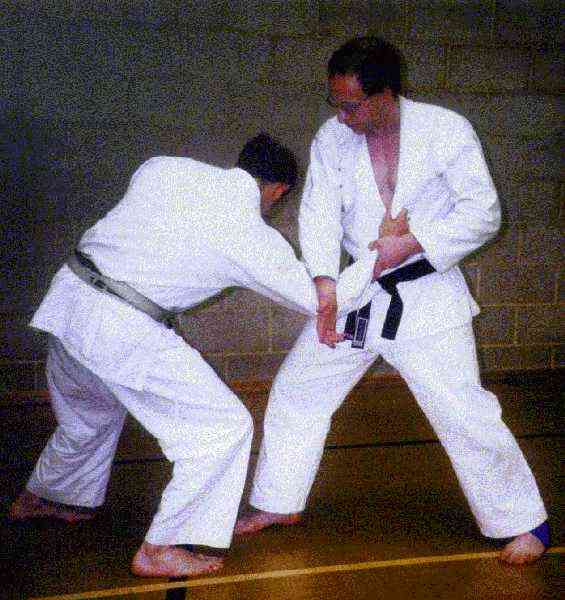
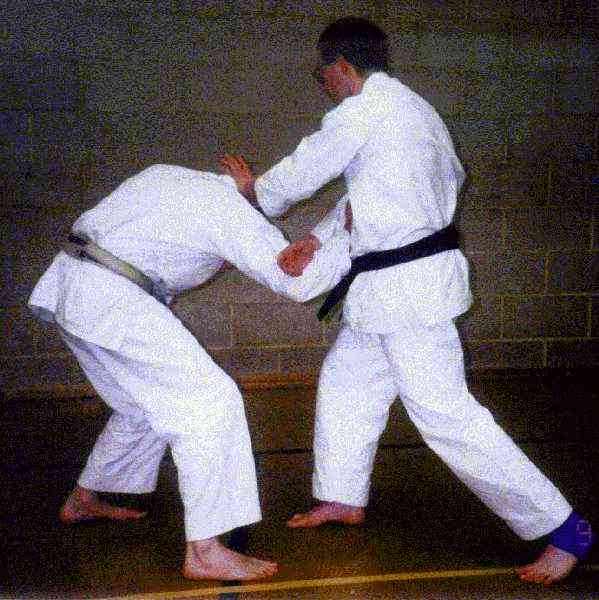
This sequence illustrates the effectiveness of a technique that follows the destructive cycle. But was it effective BECAUSE it follows the destructive cycle? Consider the following sequence. It is similar to the last but this time, uke strikes first a metal point (Large Intestine 10) and then an earth point (Stomach 5). This would also produce a knockout, but the destructive cycle is not followed.

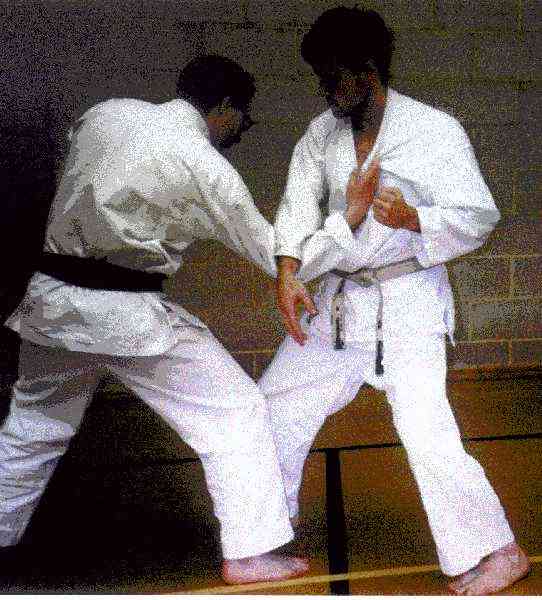
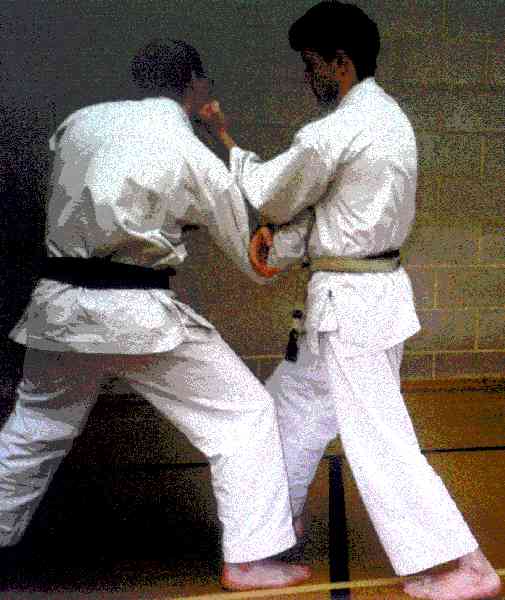
Does it matter at all what sequence of elements is followed? In order test the validity of the theory that following the destructive cycle is particularly effective, we decided to compare the effectiveness of the destructive (control) cycle against the creative cycle. This was a carried out as a double blind controlled study in accordance with accepted experimental methods. The study was 'blind' in the sense that both the person attacking the vital points and the subjects being attacked were unaware of the relationships we were attempting to test. We also 'controlled' for various other factors that might affect the results. For example, we ensured that the only TCM relationship between each pair of points was that of either the creative or the destructive cycle. Some factors could not be controlled directly but were 'randomised' – this means that if you test a large enough group of people under different random conditions then these random variations can be accounted for. Each test subject was pressed once on one point, followed immediately by being pressed on a second point. The subject was then asked to give a rating of the pain experienced when the second point was pressed. Each subject was tested twice in each session – on one side of the body using the destructive cycle and on the other using the creative cycle (the order of both left and right AND destructive or creative was randomised). This was repeated for 28 test subjects, before going on to repeat the whole experiment for another element. All 5 elements were tested in this manner, giving a total of 280 individual pain ratings. These were subjected to a rigorous statistical analysis and the conclusion was as follows: there was no significant difference between the pain caused by the destructive cycle and that caused by the creative cycle. It did appear, however, that activating points on one side of the body did result in more pain when points on the other side of the body were activated. This does give at least some credence to the claim by some instructors that stimulating a point activates the same point on the other side of the body. However, the mechanism that produced this increase in pain is still unclear.
The Shu points
In a further experiment we obtained pain ratings after a point - the target point - had been hit by itself, or when it was struck immediately after a setup point had been struck. In one condition, the setup and target points were "shu" points, which are the points on the extremities used almost exclusively by acupuncturists to manipulate qi according to the Five Elements. The two points we used were specially selected by us so that the qi imbalance caused by the setup strike should be aggravated by the target strike, according to the destructive cycle. In the other condition, the setup point and target point followed the destructive cycle, but they were not shu points. We tested 18 subjects in both conditions using the same double blind procedure as the previous experiment. We found that the setup did NOT increase the pain produced by the target strike, not even when shu points were used. In fact, the pain of the target strike was lower (although not significantly) after a setup strike had been given rather than no setup at all. So even in this special case, where the destructive cycle might be considered especially useful, there was still no evidence of its usefulness.
Conclusion
Having applied a rigorous statistical approach to testing some of the central principles of Chinese medicine as applied to pressure point fighting we have found no evidence whatsoever to support their usefulness in this setting. This is not to say that some vital points can't be used together to increase their effectiveness. It simply means that Chinese medicine theory has not thus far shown itself to be a useful model for predicting which points do work well together. However, there is at this stage a relative lack of rigorous research into this area. We would welcome therefore the input of other researchers into this field.
Full details of all the above experiments are reported in the other articles available here: